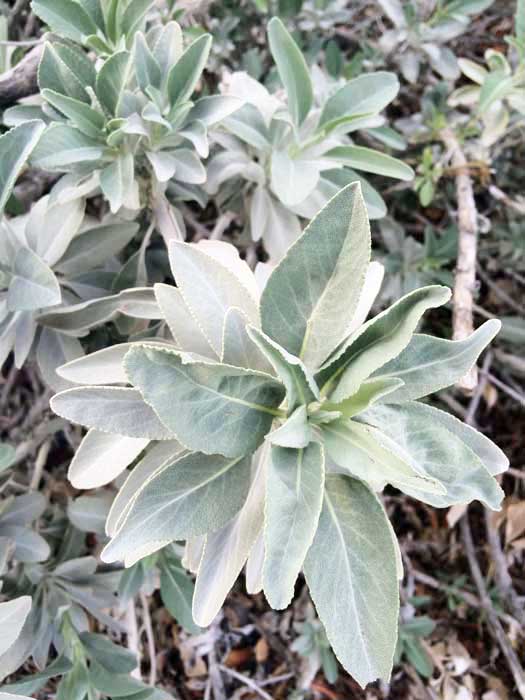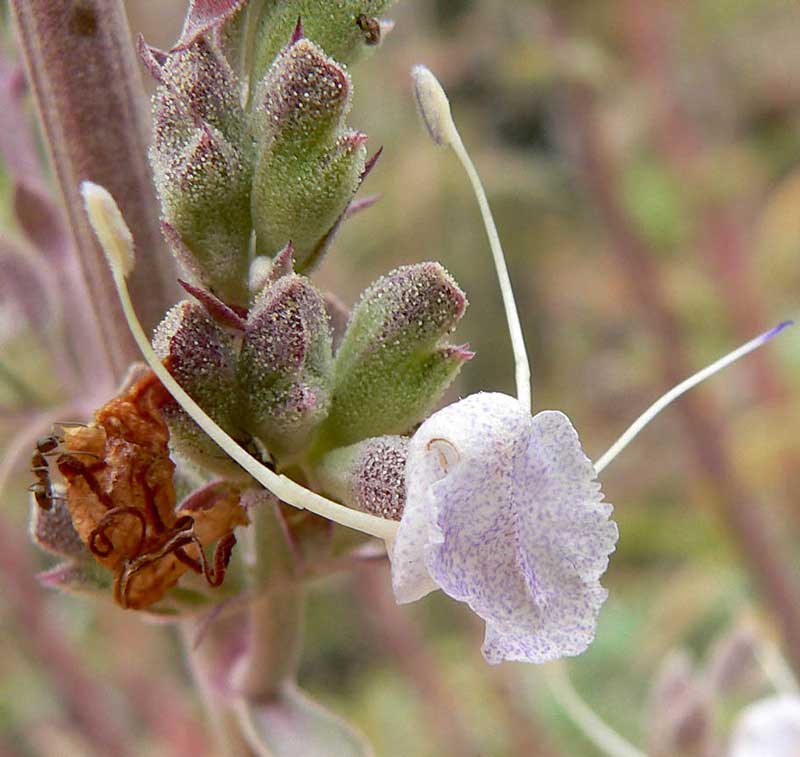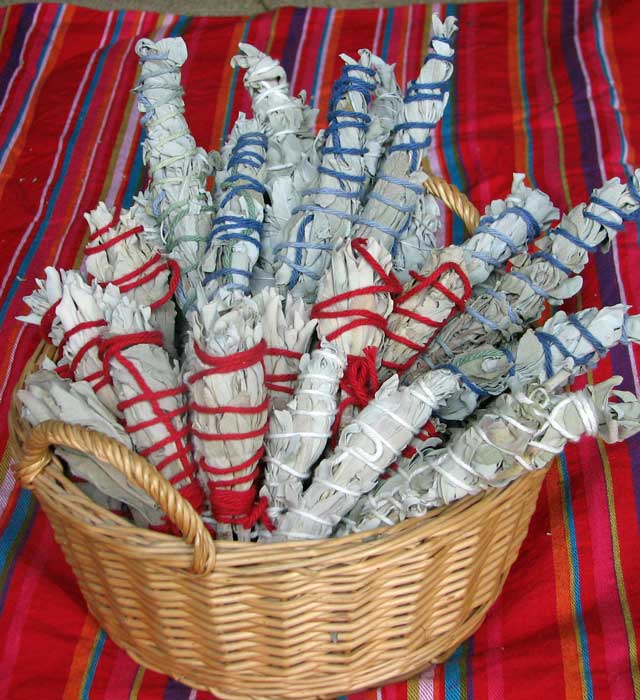Ethnobotany of southern California native plants:
White Sage (Salvia apiana)

Silver green whorls of leaves on white sage (Salvia apiana)

credit:Stan Shebs GFDL, CC BY-SA 3.0
Delicate white sage flower with lavender spots.

By Paloma Cervantes CC BY-SA 3.0, via Wikimedia Commons
White sage foliage packaged into smudge sticks.
White Sage (Salvia apiana)
White sage is a handsome, silver-colored shrub native to the southwestern US and northwestern Mexico. This perennial shrub grows throughout many plant communities between sea level and up to 7,000 feet. Salvia apiana is a member of the Mint family (Lamiaceae) and grows up to 5 feet tall.
White sage produces clusters of white, silver-grey leaves that have a very pleasant and distinct aroma. The sage scent is earthy and soothing. Whitish, purple flowers emerge from the plant in the summer. These tiny flowers are pollinated by bumble-bees, hawk moths and wasps.
This herb prefers well drained soil and lots of sun. Any well drained soil will do; white sage is found growing on granitic scree, sandy loam and red clay soils.
Purifying properties
White sage has become well known as an incense to burn for spiritual purposes. Leaves are picked and then rolled into a ‘smudge stick‘. This stick is then burned in an attempt to purify one’s body or home. This ceremonial use is reminiscent of the manner white sage was used by the original settlers of California.
Interestingly, a 1991 publication demonstrates that white sage delivers an anti-bacterial effect. Researchers at the University of Arizona found this herb can limit the growth of multiple bacteria species (Staphylococcus aureus, Bacilis subtilis, Candida, ext.)
Sage and Chia Seeds
Chia seeds have recently become popular as a food snack for health conscious folks. These seeds are highly nutritious. They’re rich in omega-3 fatty acids, fiber, protein, Vitamin B, thiamine, calcium, iron and other minerals. For this reason, these seeds are often included in smoothies, yogurts and salads. The seeds themselves are derived from a flowering sage plant also called chia. This sage, Salvia hispanica, grows natively in central Mexico and Guatemala. The Aztecs were very fond of the chia seeds. They valued this food source as highly as they valued corn. A written document from the 1500’s, the Codex Mendoza, highlights the importance of chia seeds in pre-Columbian Aztec culture.
Salvia apiana was used extensively by Native Americans in southern California.
The Luiseno people built ceremonial hunting fires from white sage foliage. This fire would supposedly bless an upcoming hunt. The Luiseno also ate the peeled, young tops of white sage stems. Once peeled, these stem tops could be eaten raw.
The Cahuilla collected seeds from white sage and mixed them with wheat flour and sugar to make gruel and biscuits. Seeds could be collected from July to September, however they needed to be parched in the sun before used as a food staple.
When members of the Cahuilla tribe suffered from colds, they would burn white sage in their sweat-houses. It was thought that inhaling the sage smoke remedied their illness.
Both the Cahuilla and Kumeyaay used white sage to address a fever, leaves were eaten or smoked in a sweat-house. An infusion of leaves was also drank to serve as cough medicine. Additionally, the leaves were burned on top of hot coals so as to fumigate a home that had been occupied by someone with measles.
White sage was also used to enhance hygiene. The Cahuilla mixed crushed sage leaves with water then used the concoction as a shampoo and conditioner. This mix of crushed leaves was also placed under their armpits to hide bad body odor. This was an advantage when trying to hide human scent from game animals during a hunt.
Showing their superstition, the Cahuilla also believed that if a women touched their hunting equipment, bad luck would be cursed upon the tribe. However, if white sage was then applied to the hunting weapons, the bad luck could be cancelled out.
July 2020 update: What happens when a famous botanical supplement becomes a medical drug?
I recently wrote this article about the mental disconnect many are facing as full spectrum cannabis approaches FDA approval in the United States.
References:
Hedges, Ken 1986 Santa Ysabel Ethnobotany. San Diego Museum of Man Ethnic Technology Notes, No. 20 (p. 39)
Sparkman, Philip S. 1908 The Culture of the Luiseno Indians. University of California Publications in American Archaeology and Ethnology 8(4):187-234 (p. 199)
Please return to our main Ethnobotany of southern California page.
On our main ethnobotany page, we present a clickable list of the southern California native plants that became a part of the culture of Native Americans and early European settlers. These plants were used for medicine, food, shelter, drink, tools and art.
Warning: The information about plants on this website is intended for general educational purposes only. The author of this website accepts no responsibility for problems arising from the user’s misidentification, misuse, or use of plants. Please read the full TERMS associated with this website.
